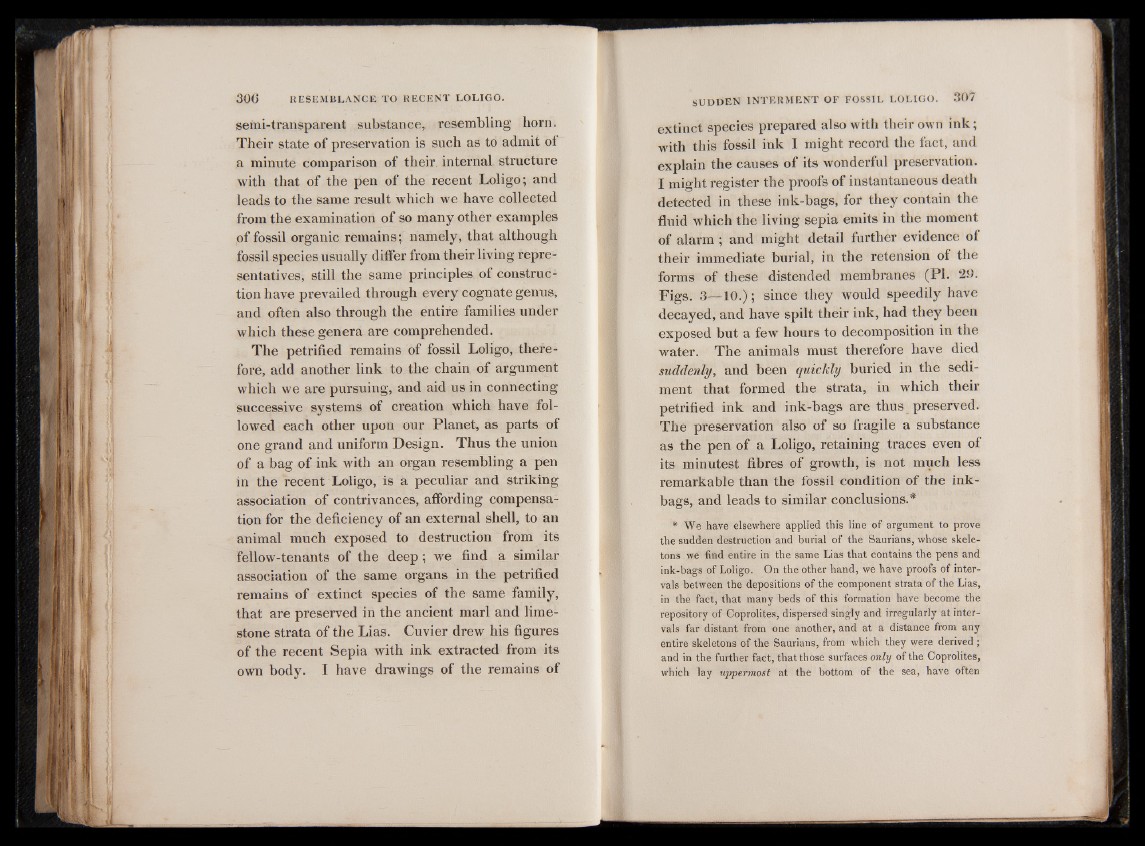
semi-transparent substance, resembling horn.
Their state of preservation is such as to admit of
a minute comparison of their internal structure
with that of the pen of the recent Loligo; and
leads to the same result which we have collected
from the examination of so many other examples
of fossil organic remains; namely, that although
fossil species usually differ from their living representatives,
still the same principles of construction
have prevailed through every cognate genus,
and often also through the entire families under
which these genera are comprehended.
The petrified remains of fossil Loligo, therefore,
add another link to the chain of argument
which we are pursuing, and aid us in connecting
successive systems of creation which have followed
each other upon our Planet, as parts of
one grand and uniform Design. Thus the union
of a bag of ink with an organ resembling a pen
in the recent Loligo, is a peculiar and striking
association of contrivances, affording compensation
for the deficiency of an external shell, to an
animal much exposed to destruction from its
fellow-tenants of the deep; we find a similar
association of the same organs in the petrified
remains of extinct species of the same family,
that are preserved in the ancient marl and limestone
strata of the Lias. Cuvier drew his figures
of the recent Sepia with ink extracted from its
own body. I have drawings of the remains of
extinct species prepared also with their own ink;
with this fossil ink I might record the fact, and
explain the causes of its wonderful preservation.
I might register the proofs of instantaneous death
detected in these ink-bags, for they contain the
fluid which the living sepia emits in the moment
of alarm ; and might detail further evidence of
their immediate burial, in the retension of the
forms of these distended membranes (PI. 20 .
Figs. 3— 10 .); since they would speedily have
decayed, and have spilt their ink, had they been
exposed but a few hours to decomposition in the
water. The animals must therefore have died
suddenly, and been quickly buried in the sediment
that formed the strata, in which their
petrified ink and ink-bags are thus preserved.
The preservation also of so fragile a substance
as the pen of a Loligo, retaining traces even of
its minutest fibres of growth, is not much less
remarkable than the fossil condition of the ink-
bags, and leads to similar conclusions.*
* We have elsewhere applied this line of argument to prove
the sudden destruction and burial of the Saurians, whose skeletons
we find entire in the same Lias that contains the pens and
ink-bags of Loligo. On the other hand, we have proofs of intervals
between the depositions of the component strata of the Lias,
in the fact, that many beds of this formation have become the
repository of Goprolites, dispersed singly and irregularly at intervals
far distant from one another, and at a distance from any
entire skeletons of the Saurians, from which they were derived ;
and in the further fact, that those surfaces only of the Coprolites,
which lay uppermost at the bottom of the sea, have often